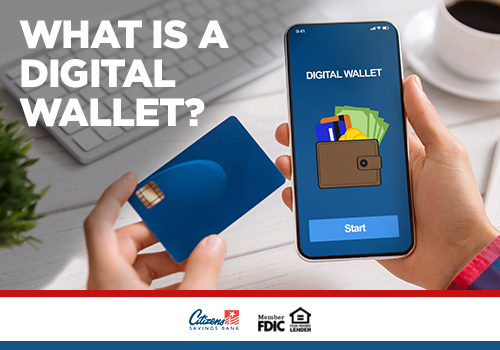What is a Digital Wallet and How Does It Work?
09/14/2023
By: Lindsey Fredericks

With the rise of contactless payments over the past several years, digital wallets have become a prominent part of many people’s lives. According to a 2022 study, nearly 90% of Americans have used at least one form of digital payment in the last 12 months, while over two-thirds anticipate switching to a digital wallet app in the next two years.
While digital wallets provide more access, efficiency, and productivity for those who use them, making the move from physical to e-wallet for the first time can be daunting. If you’re thinking about using a mobile wallet, we’re here to give you a few tips on how to get started.
What is a Digital Wallet?
Digital or electronic wallets are digital applications that securely store payment information like debit and credit cards. They can also hold tickets and passes like boarding passes for travel, concert tickets, coupons, IDs and more.
Most people choose to use their digital wallet on their smartphone for contactless payments when out and about as a mobile wallet app. However, e-wallets can also be used on desktop devices and share information from connected smartphones or tablets.
Digital wallets allow contactless transactions to be made between businesses and customers using the payment methods stored within the device. Many of these also work internationally, making it easy for customers to pay for goods and services abroad without having to use their physical card.
Benefits of a Digital Wallet
Convenience
The biggest benefit to using a digital wallet is the convenience of not needing to carry a physical wallet or multiple cards. Everything you need can be stored digitally, which is especially helpful when you need to access different cards or passes quickly. For instance, with a mobile wallet app, you can easily pull up your boarding pass at the airport, along with your photo ID and vaccination record, all from your smartphone.
Similarly, if you like to use numerous coupons throughout the week or loyalty cards for different stores, your digital wallet can save all of these. No more stuffing a Ziplock bag full of cut-out coupons and spending several minutes finding the one you want at checkout!
Beyond smartphones, other devices also have capabilities for using a digital wallet. Smartwatches can connect to your phone and share payment information stored there. By linking the two together, you increase the accessibility and convenience of your digital wallet setup.
Security
It’s very easy for physical cards to get lost or stolen, then used immediately before you can report the theft. While phones can also be stolen, the security measures on the device can buy you some time to shut down any cards in your digital wallet.
Before adding payment cards to a digital wallet, always be sure to set up the security features on your device like a fingerprint or facial recognition for login.
With digital wallets, there’s also an added security feature known as tokenization. This is where the payment details are encrypted and replaced with one-time numbers between your device and the vendor you’re paying, making it much more difficult for your payment information to be stolen.
Improved Access
One of the biggest benefits to digital wallets is the improved access they provide for unbanked or underbanked individuals. You no longer need a bank account at a branch to use a digital wallet, meaning greater access is provided for various financial services.
Funds can be stored in online-only banks, with many of these offering fewer or smaller fees for their services. This is beneficial for those who may have limited funds or a poor credit history and struggle to use traditional bank accounts.
With online banking apps, you also have around-the-clock access to all of your financial information like recent transactions. You can easily login to your app and make transfers or payments like paying bills directly from your phone.
How Does a Digital Wallet Work?
Mobile wallets work using Bluetooth or Wi-Fi and the magnetic signals within devices and payment terminals. Payments are sent securely using either Near Field Communication (NFC) or Magnetic Secure Transmission (MST).
With NFC, two devices must be located near each other for information to be shared. This is how wallets like Google Pay and Apple Pay work. Merchants must be using a compatible device at their point of sale for the payment to be made.
MSTs are similar but use the magnetic card readers at the point of sale to encrypt the data and pass this information from one device to another.
Citizens Savings Bank has multiple locations throughout Lackawanna, Wayne, and Monroe Counties. For branch locations and hours, visit our website. We also have a Customer Support Team ready to answer any questions you may have. Call us today at 1.800.692.6279 or email [email protected]. Member FDIC. Equal Housing Lender.

